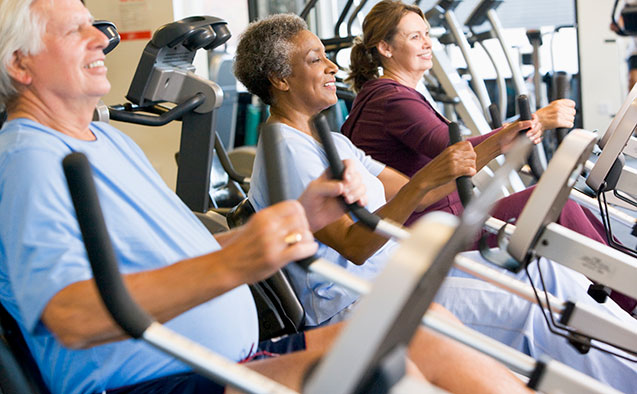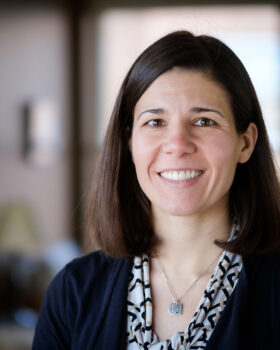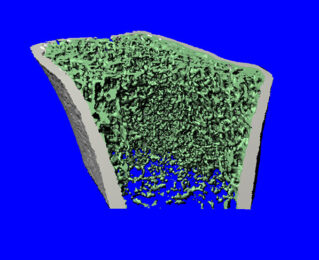Can bone-strengthening exercises and/or drugs reduce fracture risk when older adults lose weight?

Highlights
- In their latest effort to help older, overweight adults lose weight while maintaining musculoskeletal health, Wake Forest University and Wake Forest University School of Medicine researchers will test osteoporosis drugs and “bone-loading” exercises.
- Bone and muscle loss accompany weight loss as people age and can put them at greater risk of experiencing a fracture in the future. But dropping pounds helps with conditions such as diabetes and heart disease.
- A new technology called high-resolution peripheral quantitative computed tomography (HR-pQCT) will produce detailed images of bone architecture to help researchers better understand how bone responds to both intervention strategies.
A $7 million study beginning this summer at Wake Forest University and Wake Forest University School of Medicine will help determine whether a combination of resistance training plus bone-strengthening exercises and/or osteoporosis medication use can help older adults safely lose weight without sacrificing bone mass.
That paradox – that shedding pounds can help stave off heart disease and diabetes while increasing bone loss and subsequent fracture risk – has been a focus of Wake Forest researcher Kristen Beavers for about a decade.

Kristen Beavers
Her previous research has considered how resistance training helps offset bone and muscle loss associated with weight loss, and how wearing a weighted vest, a type of bone-loading activity, might help offset bone and muscle loss while dropping fat. When you apply load to your bones, through anything from walking to stair climbing, it tells the body to slow the bone loss that occurs naturally as we age.
The addition of a first line osteoporosis drug like alendronate, a bisphosphonate medication which goes by the brand name Fosamax, was the next logical step, she said.
“Bisphosphonates are FDA-approved medications that have been used for a long time to prevent and treat osteoporosis, which is age-related bone loss,” said Beavers, an associate professor in the Department of Health and Exercise Science and a principal investigator for the Bone, Exercise, Alendronate, and Caloric Restriction (BEACON) Trial.
She said the mechanisms driving age-related bone loss are not so dissimilar from those driving weight loss associated bone loss. She is hoping that results from the BEACON trial show these drugs can be repurposed to help preserve bone in older adults while they lose weight.
And that, she said, should reduce the risk of fracture and mortality, as well as increase quality of life for these individuals. According to research published in the American Journal of Medicine and the Journal of Bone and Mineral Research, more than half of all adults experiencing a hip fracture end up permanently disabled, with 25 percent likely to die in the subsequent year.
The new, five-year BEACON study, funded by the National Institutes of Health, also coincides with the arrival of state-of-the art technology to Atrium Health Wake Forest Baptist Medical Center, said Ashley Weaver, associate professor of biomedical engineering at Wake Forest University School of Medicine.

3D image of the ultradistal radius acquired using HRpQCT technology. Green coloring denotes trabecular bone while gray coloring denotes cortical bone.
The technology, called high-resolution peripheral quantitative computed tomography (HR-pQCT), is capable of producing detailed images of bone architecture so researchers can tell exactly how each intervention – resistance training with bone-loading exercises, such as hopping, and/or the bisphosphonate, alendronate – affect bone structure during weight loss.
One hypothesis is that the drug will affect trabecular bone, which is found inside the ends of long bones, such as the ankle or wrist, while the bone loading exercises will affect the outer cortical bone, the strong, dense material that protects the length of the bone.
“In the BEACON study, we have a unique opportunity to see changes in the bone much better with this tool,” said Weaver, principal investigator of the NIH-funded capital equipment grant bringing HRpQCT technology to the Wake Forest research community and co-investigator on the BEACON study.
Weaver said Wake Forest’s HRpQCT, which has been approved for research only, is the only such device within a five-hour drive of Winston-Salem.
BEACON researchers at both Wake Forest University and the University of Colorado-Anschutz Medical Campus will recruit overweight adults aged 60 or older who already have low bone mass (testing for this will be provided at no cost by the study) and are not currently taking osteoporosis medication. All participants will follow a one-year dietary weight loss program, and then will be subdivided into four groups: (1) bisphosphonate plus resistance training with bone loading exercises; (2) bisphosphonate only; (3) resistance training with bone loading exercises only; and (4) no bisphosphonate and no resistance training or bone loading exercises.
In addition to receiving the dietary weight loss program, all participants will be encouraged to do about 30 minutes per day of cardiovascular exercise (such as walking).
The interventions will last for 12 months, with bone-mass assessments at the beginning and again at six and 12 months. An optional 24-month assessment will help determine how effective the treatment was long term on bone health.
Daniel Beavers, the BEACON principal investigator with Kristen Beavers, will monitor the data collected during the study. He is working with the Division of Public Health Sciences at the medical school to develop a data-capture system that is user friendly and offers a way to easily flag data that seem unexpected.
“Data collection and monitoring is very important throughout the trial,” said Daniel Beavers, an associate professor in Wake Forest’s Department of Statistical Sciences. “High-quality data that has been reliably monitored should yield results that are more trustworthy and scientifically valid.”
The BEACON research team also includes Peter Brubaker and Jason Fanning of the Wake Forest University Department of Health and Exercise Science; Dr. Jamy Ard and Barbara Nicklas of Wake Forest University School of Medicine; and Julio Carballido-Gamio, Wendy Kohrt, Christine Swanson and Sarah Wherry of the University of Colorado School of Medicine.
Categories: Research, Top Stories
Wake Forest News
336.758.5237
media@wfu.edu
Meet the News Team
Headlines
Wake Forest in the News
Wake Forest regularly appears in media outlets around the world.




